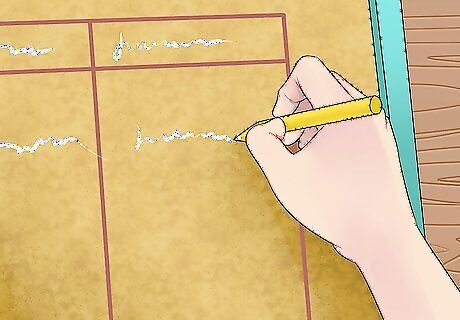
views
Acquire Survey Data

Write your own survey. This is most effective if you have access to a large group of people, such as a class of students or an office. Keep the questions basic so that you can get a good number of similar responses. For example, you could ask about favorite colors, or what they had for breakfast. Asking something more subjective, like favorite movies, will cause too much variation.

Find online surveys. If you don't have a group to survey, or you don't get enough similar answers, look online for common survey questions and responses.

Create a master answer sheet. The host will need to be able to see the top 5 responses for each question in the game.
Set Up the Game

Create the answer board. On a chalkboard, write the top 5 responses to each question followed by the number of responses each one received. Cover the written answers with taped strips of construction paper or poster board. Try to fit multiple rounds onto the chalkboard to speed the game up.

Make strike markers. Each team can get up to three strikes, so you will need six strike markers. These can be simply pieces of paper or you can create more elaborate solutions, such as bean bags or even colored light bulbs.

Purchase a timer. Alternatively, this guide can show you how to make your own.

Make a buzzer for each team. The buzzer is used to let the host know that someone on the team is ready to answer. A few beans in a small plastic container is a low cost solution.

Select teams. Traditionally, Family Feud is played with around 5 members per team. One person will need to be the host, and cannot participate on either team's side. The host is in charge of keeping track of the timer and showing the answers on the board.
Playing the Game

The host reveals the first question. Two players, one from each team, give what they think is the most popular answer. The player who picks the highest scoring answer gets to decide if their team will take control of the board or pass it to the other team.

Once a team is decided, the round begins. The players on the team in control each take turns guessing answers. The players are not allowed to talk amongst themselves. The host reveals correct answers on the board along with the number of responses it received.

Each time an answer is given that is not on the board, that team gets a strike. If after 3 strikes the board has not been fully revealed, the opposing team has a chance to steal the points for themselves. The team is allowed to confer, and if they can guess one of the remaining answers, then they win the points.

Points are awarded based on the number of responses that answer received. For example, an answer that had 15 people select it would be worth 15 points.

At the end of a predetermined number of rounds, the team with the highest point total wins.














Comments
0 comment